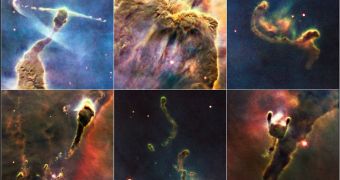The NASA Hubble Space Telescope is the most significant and relevant observatory ever deployed in our planet's orbit. Over the years, it has contributed a wealth of data to science, which helped experts discover new and exciting things about our Universe. It's safe to say that the instrument drastically changed to way we look at the field of astronomy. It has become such an icon that some of its images are renowned around the world.
In honor of the telescope's “anniversary,” NASA and the Baltimore, Maryland-based Space Telescope Science Institute (STScI) are releasing new images and online tools for people to use in connecting more closely to the telescope.
“Hubble is undoubtedly one of the most recognized and successful scientific projects in history. Last year's space shuttle servicing mission left the observatory operating at peak capacity, giving it a new beginning for scientific achievements that impact our society,” says the associate administrator of the NASA Science Mission Directorate, Ed Weiler. He reminds people that Hubble was launched during the STS-31 mission, flown by shuttle Discovery back on April 24, 1990. Despite glitches, and needing five repair missions, the instrument continued to collect valuable science for the better part of 20 years.
“To date, Hubble has observed more than 30,000 celestial targets and amassed more than a half-million pictures in its archive. The last astronaut servicing mission to Hubble in May 2009 made the telescope 100 times more powerful than when it was launched,” NASA officials write in a press release on their official website. It was only through the hard work of NASA engineers, scientists and astronauts that the observatory managed to endure for so long, despite odds that at times seemed insurmountable.
In order to celebrate Hubble's 20th anniversary, NASA and the STScI are releasing new images of a very small portion of the Carina Nebula. This is one of the most renowned stellar nurseries in the Milky Way. In such regions of space, conditions are just right to allow for the formation of new stars, from collapsing clouds of hydrogen gas and cosmic dust. Some of the new images show details of the three-light-year-tall columns of gas that reside in Carina. Some say that the new image is even more beautiful than the iconic 1995 image showing the Pillars of Creation, in the Eagle Nebula of the constellation Serpens.

 14 DAY TRIAL //
14 DAY TRIAL //